In the ever-evolving digital landscape, businesses are in a constant race to grab their audience’s attention. With many marketing strategies at their disposal, Pay-Per-Click (PPC) advertising stands out as one of the most effective. For businesses like Alliance Digital Marketing, keen on amplifying their online presence, mastering the art and science of PPC is imperative. But with the vast PPC landscape, how can one be sure they optimize their campaigns for maximum return on investment (ROI)?
Let’s embark on a comprehensive journey through the world of PPC and uncover the strategies to make every penny of your ad spend count.
Understanding PPC: A Quick Recap
Before diving into the strategies, it’s essential to establish a clear understanding of what PPC is. PPC advertising is a model where advertisers pay a fee each time their ad is clicked. It’s a way of buying visits to your site rather than earning those visits organically. The most popular form of PPC is search engine advertising, where businesses bid for ad placement in the sponsored links of search engines.
Start With Solid Keyword Research
The cornerstone of a successful PPC campaign is selecting the right keywords. Tools like Google Keyword Planner and SEMrush can help you identify terms related to your business, showing their search volume and competition. Aim for a blend of:
- High-intent keywords: These are terms that users type in when they’re closer to making a purchase. For instance, ‘buy leather shoes online’.
- Long-tail keywords: These are longer and more specific phrases that customers use, often with lower competition and cost-per-click (CPC). E.g., ‘best leather shoes for hiking’.
1- Optimize Your Ad Copy
Your ad copy should be compelling and resonate with the searcher’s intent. Ensure it:
- Highlights your unique selling proposition (USP): What sets you apart from competitors? Maybe it’s free shipping, a limited-time discount, or unmatched quality.
- Includes a clear call-to-action (CTA): Guide users on the next steps. Whether it’s ‘Shop Now’, ‘Learn More’, or ‘Sign Up’, make it stand out.
2- Landing Page Relevance
After clicking on your ad, users should land on a page that matches their search intent. A dedicated, well-designed landing page can drastically improve conversion rates. Ensure it’s:
- Mobile-optimized: With most searches coming from mobile devices, your landing page must be mobile-friendly.
- Fast-loading: Speed is crucial. A delay of even a few seconds can lead to lost conversions.
- Highly relevant: The content should align with the ad copy and offer value.
3- Monitor and Adjust Your Bids
Different keywords and times of the day might deliver varying results. Regularly monitor your campaigns and adjust your bids accordingly. Maybe you find that specific keywords perform better during weekends; you can increase your requests for those times and reduce less productive hours.
Utilize Ad Extensions
Ad extensions provide additional information and can boost the visibility of your ads. Some popular extensions include:
- Sitelink extensions: Link to specific pages of your site (e.g., product categories, about us).
- Callout extensions: Highlight special offers or features (e.g., ’24/7 Customer Support’).
- Structured snippet extensions: Showcase specific aspects of your products or services (e.g., ‘Brands: Nike, Adidas, Puma’).
1- A/B Test Your Campaigns
To determine what works best for your target audience, regularly test different versions of your ads and landing pages. For instance, try varying CTAs or headlines and compare the results.
2- Track and Analyze with Analytics Tools
Platforms like Google Analytics can provide deep insights into how users interact with your ads and website. Set up conversion tracking to understand which campaigns, keywords, or ad groups drive the most conversions. This data can help in refining your strategies.
3- Explore Remarketing Campaigns
Remarketing allows you to show ads to users who’ve previously visited your site but didn’t convert. With tailored ad copy and offers, you can re-engage these potential customers and boost conversions.
4- Stay Updated with PPC Trends
The digital advertising world is dynamic. Stay updated with the latest trends, tools, and technologies in PPC. Platforms like Google Ads and Facebook Ads regularly roll out new features that can offer competitive advantages.
5- Consider Diversifying Platforms
While Google Ads is the most popular PPC platform, pay attention to others like Bing Ads, Facebook Ads, or LinkedIn Ads, especially if your target audience is active there.
Conclusion
The realm of PPC advertising offers endless possibilities. By diving deep, continually learning, and adjusting their strategies based on data, businesses can get the best bang for their buck. At Alliance Digital Marketing, we understand the nuances of the digital landscape and are committed to helping companies navigate the intricate web of PPC. With the right approach, every click can be a step closer to a conversion, ensuring maximum returns on your ad spend.

